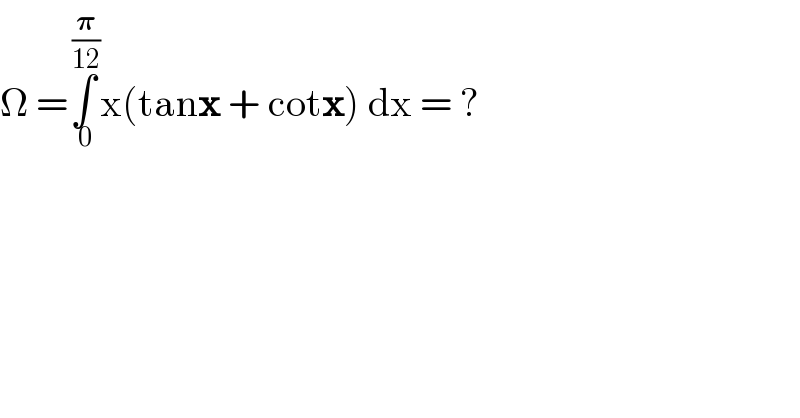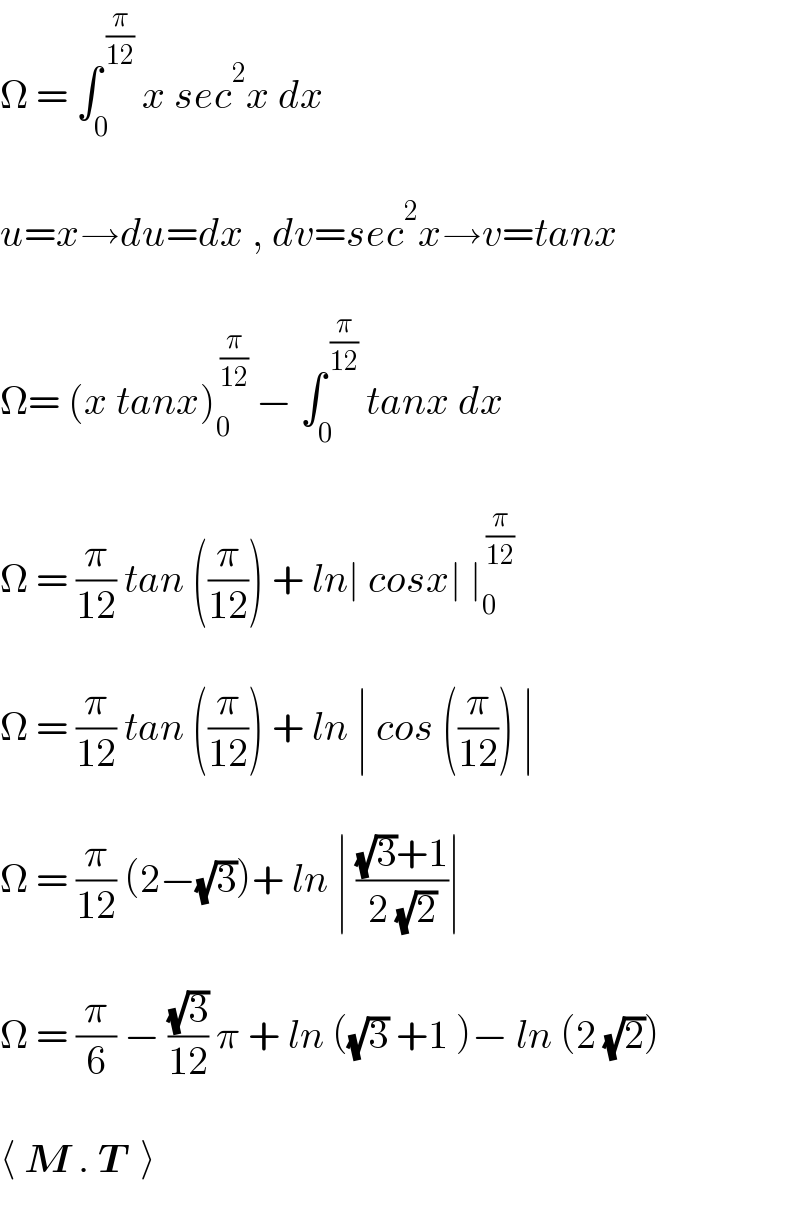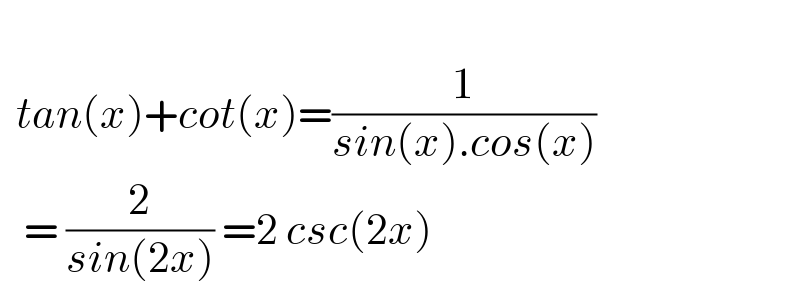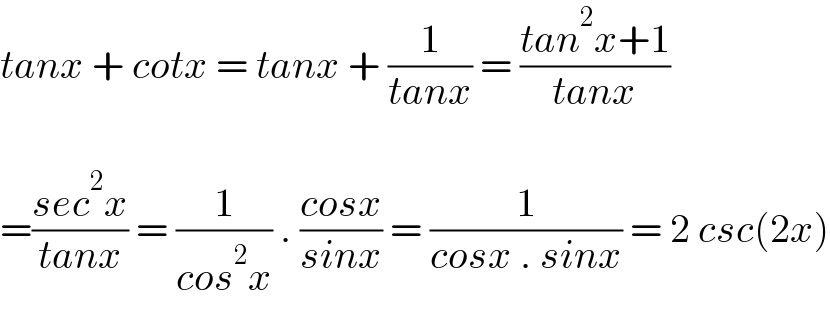Question Number 154011 by mathdanisur last updated on 13/Sep/21

$$\Omega\:=\underset{\:\mathrm{0}} {\overset{\:\frac{\boldsymbol{\pi}}{\mathrm{12}}} {\int}}\mathrm{x}\left(\mathrm{tan}\boldsymbol{\mathrm{x}}\:+\:\mathrm{cot}\boldsymbol{\mathrm{x}}\right)\:\mathrm{dx}\:=\:? \\ $$
Commented by alisiao last updated on 13/Sep/21

$$\Omega\:=\:\int_{\mathrm{0}} ^{\:\frac{\pi}{\mathrm{12}}} \:{x}\:{sec}^{\mathrm{2}} {x}\:{dx} \\ $$$$ \\ $$$${u}={x}\rightarrow{du}={dx}\:,\:{dv}={sec}^{\mathrm{2}} {x}\rightarrow{v}={tanx} \\ $$$$ \\ $$$$\Omega=\:\left({x}\:{tanx}\right)_{\mathrm{0}} ^{\:\frac{\pi}{\mathrm{12}}} \:−\:\int_{\mathrm{0}} ^{\:\frac{\pi}{\mathrm{12}}} \:{tanx}\:{dx} \\ $$$$ \\ $$$$\Omega\:=\:\frac{\pi}{\mathrm{12}}\:{tan}\:\left(\frac{\pi}{\mathrm{12}}\right)\:+\:{ln}\mid\:{cosx}\mid\:\mid_{\mathrm{0}} ^{\:\frac{\pi}{\mathrm{12}}} \\ $$$$ \\ $$$$\Omega\:=\:\frac{\pi}{\mathrm{12}}\:{tan}\:\left(\frac{\pi}{\mathrm{12}}\right)\:+\:{ln}\:\mid\:{cos}\:\left(\frac{\pi}{\mathrm{12}}\right)\:\mid \\ $$$$ \\ $$$$\Omega\:=\:\frac{\pi}{\mathrm{12}}\:\left(\mathrm{2}−\sqrt{\mathrm{3}}\right)+\:{ln}\:\mid\:\frac{\sqrt{\mathrm{3}}+\mathrm{1}}{\mathrm{2}\:\sqrt{\mathrm{2}}}\mid\: \\ $$$$ \\ $$$$\Omega\:=\:\frac{\pi}{\mathrm{6}}\:−\:\frac{\sqrt{\mathrm{3}}}{\mathrm{12}}\:\pi\:+\:{ln}\:\left(\sqrt{\mathrm{3}}\:+\mathrm{1}\:\right)−\:{ln}\:\left(\mathrm{2}\:\sqrt{\mathrm{2}}\right) \\ $$$$ \\ $$$$\langle\:\boldsymbol{{M}}\:.\:\boldsymbol{{T}}\:\:\rangle \\ $$
Commented by mathdanisur last updated on 13/Sep/21

$$\mathrm{Ser},\:\:\mathrm{tan}\boldsymbol{\mathrm{x}}+\mathrm{cot}\boldsymbol{\mathrm{x}}=\mathrm{sec}^{\mathrm{2}} \boldsymbol{\mathrm{x}}\:\:\boldsymbol{\mathrm{or}}\:\:=\mathrm{sec}^{\mathrm{2}} \mathrm{2x}\:.? \\ $$
Commented by mnjuly1970 last updated on 13/Sep/21

$$ \\ $$$$\:\:{tan}\left({x}\right)+{cot}\left({x}\right)=\frac{\mathrm{1}}{{sin}\left({x}\right).{cos}\left({x}\right)} \\ $$$$\:\:\:=\:\frac{\mathrm{2}}{{sin}\left(\mathrm{2}{x}\right)}\:=\mathrm{2}\:{csc}\left(\mathrm{2}{x}\right)\: \\ $$
Commented by tabata last updated on 13/Sep/21

$${tanx}\:+\:{cotx}\:=\:{tanx}\:+\:\frac{\mathrm{1}}{{tanx}}\:=\:\frac{{tan}^{\mathrm{2}} {x}+\mathrm{1}}{{tanx}} \\ $$$$ \\ $$$$=\frac{{sec}^{\mathrm{2}} {x}}{{tanx}}\:=\:\frac{\mathrm{1}}{{cos}^{\mathrm{2}} {x}}\:.\:\frac{{cosx}}{{sinx}}\:=\:\frac{\mathrm{1}}{{cosx}\:.\:{sinx}}\:=\:\mathrm{2}\:{csc}\left(\mathrm{2}{x}\right) \\ $$
